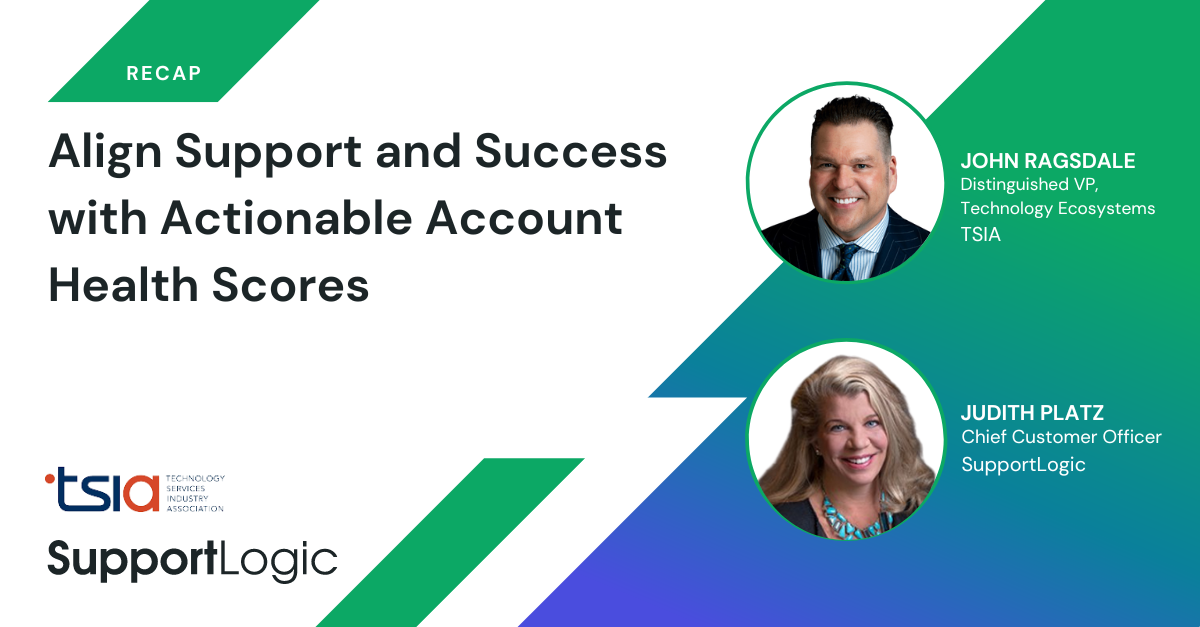
Dec 22, 2022
5 Gifts to Customer Support from AI
Support Experienceproactive supportagent managementagent performancepredict escalationschurn reduction
AI in customer support gives agents more time to handle complex issues and helps teams save money. But how does AI impact the customer experience?
To answer this question, our founder and CEO, Krishna Raj Raja, spoke with Jim Roth, executive vice president of customer success at Salesforce, during a session at the TSIA World: Interact Conference. They discussed how AI in customer support has helped support teams deliver better, more personalized experiences to customers.
Let’s go over five key points from this conversation about how AI technology enhances the customer experience and drives revenue growth.
1. Finds your needle in the haystack
When customers experience a problem with your product or service, naturally they want it to be resolved as quickly as possible. While some cases can be dealt with in a few minutes, others are much more complicated and time intensive.
While these difficult cases only make up a small percentage of your total cases, Jim noted that these complex cases aren’t always easy to identify. And if you can’t figure out which cases are more challenging, they’re likely to escalate to management or engineering and become long-running problems.
SupportLogic SX predicts which cases will be more difficult, so your customer support team can prioritize them.
Our software uses natural language processing (NLP) to extract relevant data from all of your cases—even unstructured data like emails and messages. From there, our AI models analyze this data to classify cases by urgency, customer history, case activity, support responsiveness, and the age of the case.
With these factors in consideration, our machine learning algorithm then identifies which cases are difficult and likely to escalate so your customer support team can address these issues before they get worse.
2. Tracks cases closer to real time
Most companies rely on static surveys like CSAT and NPS to evaluate their customer experience. While these metrics can offer some insight into the quality of your customer support, the surveys are limited because they provide you with lagging indicators. The responses are typically gathered after cases are resolved, and they may be delayed if customers are slow to submit answers.
Jim noted that call audits are another way to gauge customers’ feelings, but they’re expensive and limit you to a small sample size. And by assessing the quality of a case resolution only after it’s completed, you don’t have the opportunity to proactively resolve issues.
To improve your customer support faster, you need to know how your customers actually feel during their cases. Leading indicators like customer sentiment and attention score allow you to better understand your customers’ needs and concerns throughout the lifecycle of the case.
SupportLogic’s AI continually extracts customer data in real time to generate customer sentiment scores (the higher the score, the happier the customer). An accompanying attention score tells you when a case becomes more urgent and needs immediate attention.
These combined metrics accurately indicate support quality and high-priority cases, so agents can take action to improve your support before it’s too late. Krishna also notes that real-time sentiment analysis keeps agentss from sending surveys to customers who are already frustrated.
3. Develops your team’s soft skills
When your customers come to you with a problem, they want more than just a solution—they want a support agent who’s understanding and helpful. Zendesk’s 2021 Customer Experience Trends Report found that 49% of customers want agents to be empathetic.
Which makes sense. By the time customers connect with support, they’re typically frustrated or confused. Agents with strong soft skills—like emotional intelligence and problem solving—can help customers feel understood and win their trust.
To develop these qualities in agents, Krishna emphasized the need for detecting soft skills gaps in teams and identifying cases with coaching opportunities. Our AI-enabled platform does just that.
SupportLogic analyzes all of your cases to identify positive, negative, and neutral customer interactions—enabling managers to coach in real time. Coaching an agent closer to the notable event helps them remember it better and learn more. Additionally, the agent scorecard functionality gives managers a complete picture of each agent’s overall performance with metrics like backlog and escalations.
4. Boosts your team’s morale
Case escalations don’t just affect the customer. When support agents constantly interact with dissatisfied customers, they often end up burned out.
Nearly 75% of contact center agents are at risk for burnout, with another 30% at an even higher risk. As Krishna explains, “Nobody wants to talk to an angry customer all day long and then lock up.”
Burnout often leads to high employee turnover as agents leave to find opportunities with less stress. Meanwhile, the burned out agents who do stay tend to have a negative attitude with customers, which is one of the top five reasons that drive customers away from a brand. Simply put, a bad agent attitude is bad for business.
SupportLogic’s AI predicts and even prevents escalation, so agents are less likely to be overwhelmed.
By measuring indicators like customer sentiment and urgency, SupportLogic helps teams reduce escalations (Nutanix saw a 40% reduction with our platform). When agents deal with fewer and shorter cases, they have more space to resolve customers’ issues and grow their skills.
5. Protects and grows revenue
When cases aren’t resolved in a timely manner, you run the risk of losing people before they even become customers or existing customers reducing their product usage. In fact, 63% of customers surveyed would actually pay more to get better customer service.
If you can predict when customers are at risk of churning, then you can proactively reach out to them to keep their service experience positive—encouraging them to continue doing business with your company in the long run.
Our intelligence platform uses natural language processing to extract signals that indicate churn risk, like a customer mentioning a contract cancellation, refund, or even a competitor’s name. SupportLogic’s AI then provides context for why the customer is at risk of churning so support managers can take the right action to prevent this. By acting on these signals, data integration provider Fivetran reduced churn by 25%.
Bonus: Frequently asked questions about implementing an AI-based customer support tool
Now, let’s dive into some questions from the audience:
1. How do you get customers to adopt new support channels like chatbots?
Here are three tips to improve chatbot adoption among your customers:
- Promote the chatbot as a new channel: Take every opportunity to highlight your chatbot to customers—on the phone, in the message queue, and on your website. Make sure to emphasize the benefits of using a chatbot, like self-service, 24/7 availability, and faster responses.
- Make the chatbot the best possible experience: Configure your chatbot to answer frequently asked questions about topics like pricing, stock availability, and technical requirements. If customers see how effective a chatbot is at answering their questions or resolving their issues, chances are they’ll return to the chatbot for future queries.
- Always provide the option to talk to a human: While AI chatbots can handle many customer support requests quickly, people still want the option to talk to another human. If your customers can’t connect with a human agent, they’re likely to abandon the chatbot altogether.
2. How do you provide your AI tool with the right feedback to get the results you want?
The true intelligence of AI is in its ability to adapt as the data changes. To adjust, your AI tool should be a closed-loop system so that it can learn from your data.
After the AI has started gathering data from your previous and current integrations, make sure to correct any false positives and retrain the model so the AI can adapt to the most accurate data possible. While a machine learning model usually works independently, it does periodically require some human interaction to ensure it delivers the results you want.
3. How hard is it to “cold start” this process?
The power of collective intelligence means that instead of just relying on one dataset, SupportLogic can also use data from other customers to develop AI models. For customers with little to no history of data, pre-trained models are available and ready to deploy on day one.
To discover how to use AI in customer support to drive more predictive, proactive workflows in your support team, book a demo today.
Don’t miss out
Want the latest B2B Support, AI and ML blogs delivered straight to your inbox?





